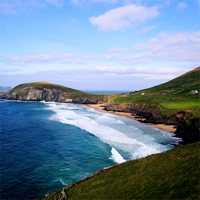Day 1 in Dingle
Welcome to Dingle! Arrive at your hotel, check in and then head to the pier where you can book a one hour boat tour to see Fungie, the Dingle Dolphin (weather permitting) and take pictures with the dolphin statue. Afterwards, grab a bite to eat or an ice cream at Murphy's (a must do in Dingle) before heading out to explore the town a bit. If the weather isn't cooperating then visit the Oceanworld Aquarium instead.
This afternoon, drive the dramatic Conor Pass, the highest mountain pass in Ireland (if you didn't come in to town this way). This narrow, twisting road runs between the town of Dingle and Kilmore Cross on the north side of the peninsula and provides the most breathtaking views of the mountains and corrie lakes. From the scenic carpark at the summit there are views as far as the Aran Islands off County Galway.
Later, enjoy a fresh seafood dinner, traditional Irish music and a couple pints (or drams of whiskey) at one of the local pubs. Finish the evening with a stroll through the pastures or along the beach to Hussey's Folley. The tower, once used as a lighthouse, sits at the mouth of Dingle Bay.


Day 2 in Dingle
Wake up early this morning and spend the day driving the famous Slea Head Drive. (Be sure to pack plenty of snacks and drinks as there are few shops to be found west of Dingle Town). After leaving Dingle, you will pass over Milltown Bridge, past the woodlands at Burnham to the seaside village of Ventry. The long, curved strand (beach) is a blue flag beach and offers a safe spot for swimming and water sports. From Ventry, drive westward to Dunbeg Fort. Perched on the edge of a cliff above Dingle Bay, this small, well-weathered fort was an important defensive promontory site during the Iron Age. About a half a mile from the fort, you will find an interesting group of clocháns, built of drystone and set on the southern slopes of Mt. Eagle looking out across the sea to Skellig Michael. The clocháns can be visited for a small fee (approximately €2) paid to the local farmer.
At Fahan the road crosses a ford then reaches Slea Head itself, marked by a stone crucifix, and offering stunning views to South Kerry and the Blasket Islands. Follow the coast north, past Coumenoole Strand, to Dún Chaoin where it is possible to board a passenger ferry to the Great Blasket from Dún Chaoin pier. Here, you may also want to visit the Blasket Center, a fascinating heritage center and museum honoring the unique community who lived on the remote Blasket Islands until their departure in 1953. The Blasket islanders were great storytellers and the center celebrates their use of the Irish language with videos and exhibitions. (The center also offers a cafeteria if you want to stop for a wee bite).
The drive then proceeds north and east from Dún Chaoin through open countryside as it moves inland to the village of Ballyferriter, home of the Corca Dhuibhne Regional Museum. Heading east, you will find a number of ancient monuments, such as the early Christian site at Reasc and Gallarus Oratory. The next stop is Kilmalkedar, the most important church site on the Dingle Peninsula. This is one of the finest surviving examples of Romanesque architecture with Ogham stones on display in the churchyard. Continuing north, you will pass through the fishing village of Ballydavid along a cliff-top route with a dramatic seascape of crashing waves, rocks and seabirds below. Cross the bridge at Feohanagh and the route brings you to Brandon Creek, the legendary starting point of the voyage of St Brendan to America (centuries before Columbus). Now turn south and run along the base of Mount Brandon, the second highest mountain in Ireland, before rejoining the main road, passing over a hill's crest at Ballinlochaigh and arriving back at Dingle.



Additional Days in Dingle
Should you be able to spend additional days in Dingle then you should consider a trip to the Iveragh Peninsula to drive the famous Ring of Kerry or explore Killarney National Park and the Gap of Dunloe, a ruggedly beautiful mountain pass through the MacGillycuddy's Reeks mountain range. Within the park's limits you will find two estates, Muckross House and Gardens and Knockreer House, as well as the remains of medieval abbeys and castles. The park is also home to the famous Torc Waterfall and the three Lakes of Killarney. The largest of these is the Lower Lake where you will find historic Ross Castle. Innisfallen Island sits approximately one mile offshore from Ross Castle and is home to the ruins of Innisfallen Abbey. Time permitting you may want to take a boat tour out to the island (available for hire at Ross Castle).
You may also enjoy a trip to Skellig Michael, a remote, rock-hewn monastery, and an UNESCO World Heritage Site, known for its unique bee hive huts and population of Puffins. The boats to Skellig Island launch from the tiny fishing village of Portmagee as long as the tides allow. (You must be in good physical condition to attempt the climb up the steps to the monastery because it can be very exhausting). In addition, Valentia Island can be reached across the bridge at Portmagee.


Your Last Day in Dingle
Depart your hotel for the airport for your return home. Please remember to leave enough time to return your rental car before your flight out.
